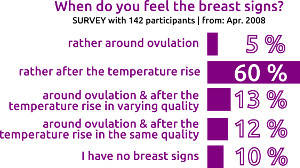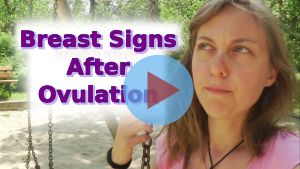Many women observe slight breast pain after ovulation. What the breast symptom can reveal and how you can use it to get pregnant.
Many women incredibly observe tensioning of the breast or slight pain in the breast as the next menstrual period draws near. Why do these mysterious breast pains occur? Can this breast symptom, as it is called in professional circles, tell us without doubt when ovulation is over? In this article, you will get the answers and many more tips on how to use the breast symptom.
When and why do the breast pain or the breast symptom occur?
The causes of the origin of the breast symptom have not yet been fully clarified. Most scientists assume that the breast symptom is a kind of first preparation for milk production after pregnancy or lactation. In the course of pregnancy, the breasts are constantly changing, in order to be prepared a little for breastfeeding. In the temperature peak, the body in each cycle assumes that there has been a fertilization of egg and sperm (although the body does not yet know exactly), and prepares both the uterine lining for the performance of the egg and the breast for the (hopefully) coming baby. The breast symptom is hormonally associated with the production of the pregnancy hormone progesterone, which is increased throughout the pregnancy and is predominantly active at a high level shortly after ovulation.

Users of the Symptothermal method can narrow down ovulation and high levels very precisely. According to a survey in the Symptothermal Method Forum, about 60% of women only feel the breast symptom in the high level. At about 25%, it occurs both in the higher level and at the time of ovulation. Only 5% can experience the slight breast pain near ovulation. About 10% of the women surveyed have never been able to observe the breast symptom.
Do the breast pain clearly indicate the time after ovulation?
Yes, but only in combination with a measured basal temperature curve. The breast symptom is an additional symptom similar to the middle pain and the ovulation bleeding and is not meaningful enough on its own to clearly determine the time after the ovulation. However, using the basal temperature and the cervical mucus, you can use the breast symptom very well to be even more sure that ovulation is really over. Similar to the following cycle, my partner Anne also observed the breast symptom in most of her cycles:

My girlfriend usually watches the breast symptom for several days. She often notices it very clearly shortly before menstruation. This is always very practical because my partner usually knows a few days before that her days will start soon. The menstrual prognosis is very reliable and I have met many women who use the Breasts symptom as a menstrual prediction.
Is the breast symptom a sign of pregnancy?
Interestingly enough, Anne also had a severe breast symptom in her pregnancy cycle. She thought when the menstruation will finally come, then the tension will subside, because the progesterone level drops again and a new cycle begins. But the menstrual period just didn’t come. If your high level lasts longer than 18 days from the first higher basal temperature reading, then you are very likely to become pregnant. If you still feel a persistent breast symptom, you can be more confident that it worked and you are pregnant.
Breast pains vs. Breast tingling
Those who feel a tingling rather than a tension around ovulation have noticed a very rare ovulation sign. Breast tingling is often confused with breast symptoms in women, probably due to increased estrogen production around ovulation. This noticeable tingling sensation is another sign of ovulation that combined with temperature rise, transparent spinnable cervical mucus, ovulation bleeding, and/or middle pain makes you even more confident that you are very close to your Ovulation. The breast tingling feels relatively pleasant in contrast to the breast symptom – more like an itch or tingling inside the breast – and occurs predominantly in the ova maturation phase shortly before ovulation. On the other hand, the breast symptom tends to be associated with pain or tension and occurs more in the luteal phase after ovulation.
Conclusion
The breast symptom is an exciting body sign that you can use in combination with temperature and mucus observation to be even more confident that you are in the high level. On its own, however, the breast symptom is not suitable to ascertain that you are in the post-ovulation period. Many women using the Symptothermal method, use the breast symptom as a menstrual prognosis, as it usually starts regularly before menstruation. In combination with the basal temperature, the breast pain in the second half of the cycle can also be used as signs of pregnancy if the temperature is increased for more than 18 days. However, the most important Ovulation-Signs remain the basal temperature in combination with cervical mucus or cervix. With the Symptothermal method, these body signs can be used to limit ovulation to a few days, a pregnancy is detected without a pregnancy test and the highly fertile days are reliably limited. When you know when you’re fertile, you also know when you need to have sex to get pregnant. This information has helped many women to become pregnant, even if it has not worked out for a long time. If you want to learn more about the Symptothermal method, how it works and what you need for it, I recommend the Get Pregnant Starter SetGet Pregnant Starter Set. With this set, many women I have accompanied have become pregnant quickly and easily.
❊ Fertile Greetings and wishes❊
Yours, Anne ❥




